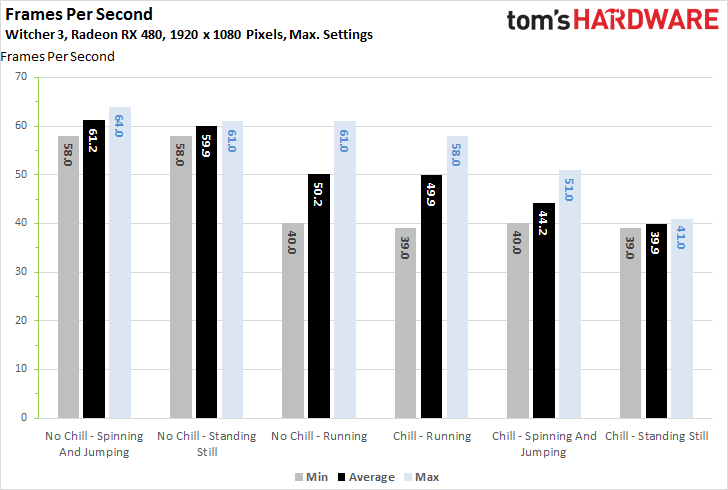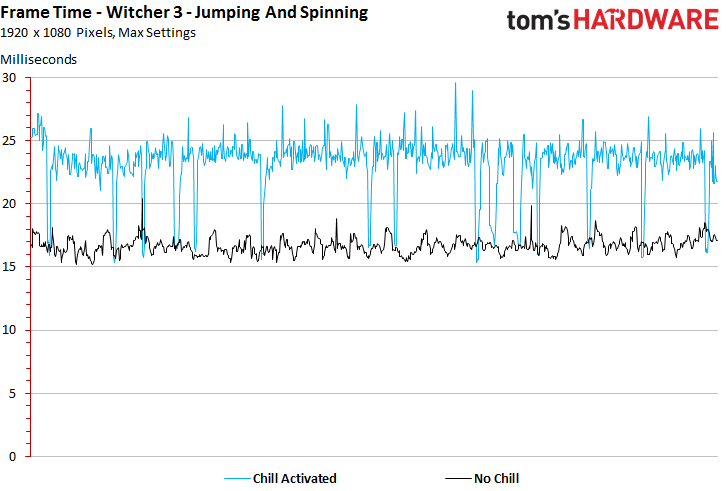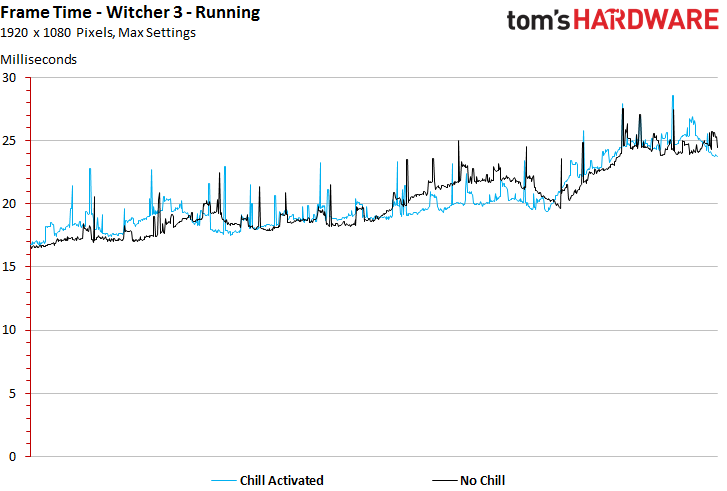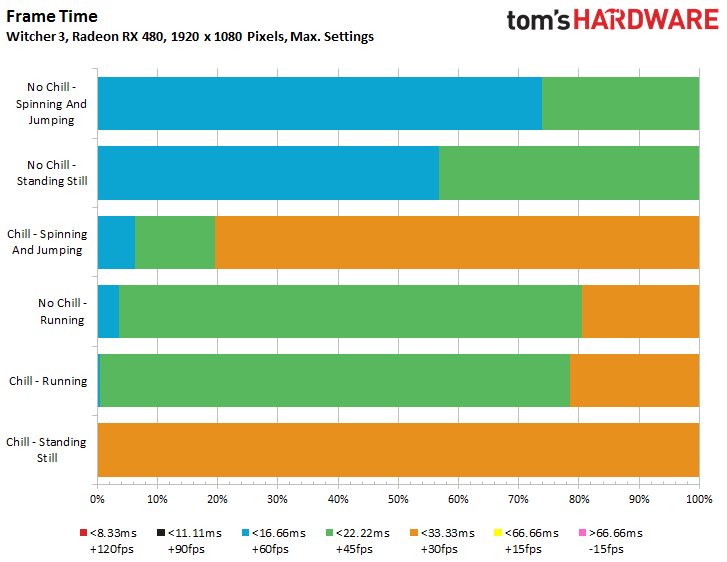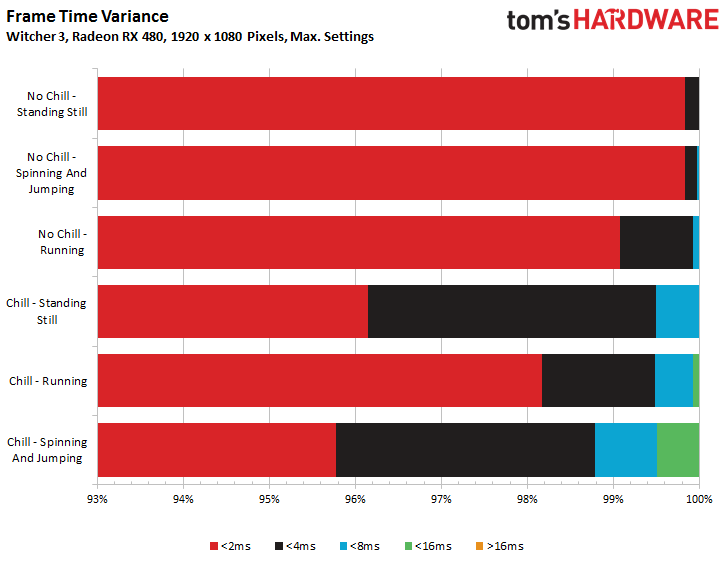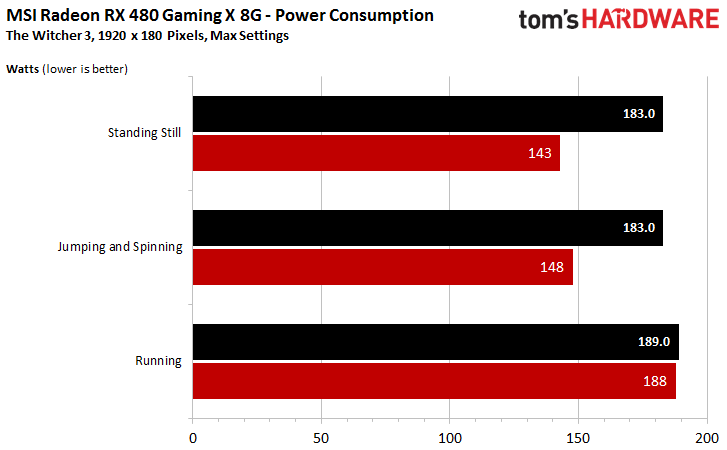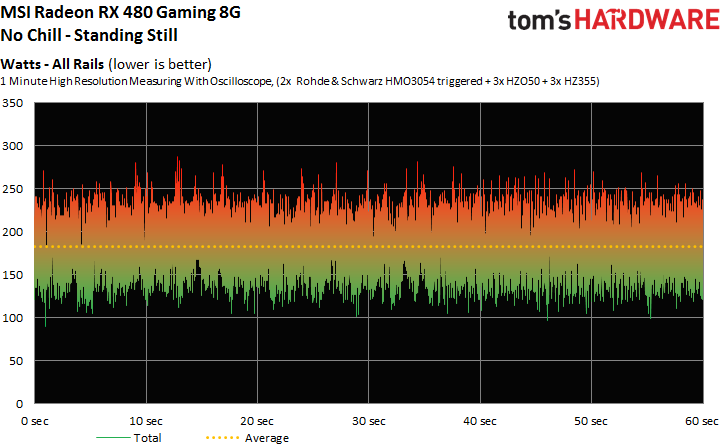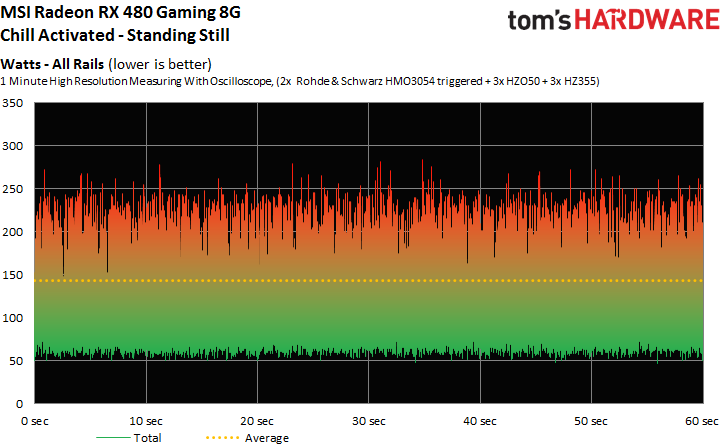Benchmarking AMD Radeon Chill: Pumping The Brakes On Wasted Power
Radeon Chill: Performance And Power Consumption
FPS: All or Nothing?
Looking at performance alone misses the point of Radeon Chill, but we still want to see how AMD's feature affects frame rates in absolute terms. Just try not to think of this chart as "higher is better," because that's not what we're trying to show.
Right out of the gate, we see the most demanding scene diminishes the impact of Radeon Chill the most, just as we were expecting. Meanwhile, the frame rate drops quite a bit in the sequence with the least amount of motion. That's pretty much what AMD is advertising.
But as we know, frames per second is too broad of a metric to represent performance on its own. Frame time is often much more important, particularly when it comes to measurements that involve smoothness. And Radeon Chill definitely needs to be checked for its effect on frame delivery.
We begin with the first scene, where Geralt is standing still. It's important to note that we dialed in the highest-quality settings, just as a real gamer would do playing The Witcher 3 at 1920x1080 on a Radeon RX 480. No doubt, AMD would have rather have us use a less demanding detail preset to show Chill pumping the brakes on 100 FPS+ performance. Frame times would have looked better in absolute terms. However, we want to represent real-world game play and not some hypothetical case. Our conclusion would have been the same anyway.
Now let's rotate the camera or get Geralt to jump around and throw some attacks. Color starts coming into play, and we can see the rapid performance increase once movement demands higher frame rates (identifiable through lower frame time values).
Dynamic movement is smooth, as it should be, and the already-calculated scenery uses less power.
It's time to run around and deliberately try to force prevent Radeon Chill from having an effect. The two lines track each other closely as performance needs outweigh Chill's proclivity for power-saving.
Get Tom's Hardware's best news and in-depth reviews, straight to your inbox.
Let us now compare the frame times as a bar chart, broken up into intervals:
Frame time variance increases as Radeon Chill becomes more active, though this is what we'd expect from a feature designed to relax performance in the name of lower power consumption.
Subjectively, the RX 480's frame delivery is smoother than the bars suggest. It's certainly not ideal, though. We think you'll want a FreeSync-capable monitor to truly maximize what Radeon Chill brings to the table...so long as your realized frame rates fall within the display's variable refresh rate range.
Power Consumption
Of course, the reason for Chill's existence is lower power consumption. And as the chart below shows, our savings is up to 22%. It's no wonder AMD would like to throttle down from 90 to 40 FPS.
In the real world, though, when were you ever seeing 90 or 100 FPS? Unless you're playing StarCraft or Counter-Strike at their highest detail settings, those figures aren't realistic on an RX 480 at 1920x1080. AMD's whitelist has a lot of lush-looking games on it that won't get quite so much benefit from Radeon Chill, since they won't be modulating performance as much as the less-demanding titles.
To go with the stand-still test's frame time benchmarks, we also have power consumption measurements in the same scene, with and without Radeon Chill:
When Radeon Chill is activated, the measured minimum values drop significantly, along with the peaks. As a nice side-effect, noise output drops as well.
Summary And Conclusion
What do you do as a manufacturer when you are constantly being criticized for higher power consumption and lower efficiency than the competition? That's right, you come up with ways to reduce unnecessary work, and when your hardware has the chance to idle (even on a millisecond basis), you seize the opportunity to save some power.
Radeon Chill is not a silver bullet, and it cannot make up for AMD's architectural disadvantages. However, if a game is well-suited to the feature's strengths, then there are clear savings to be had by enabling Chill. This feature does help supported cards run cooler, and thus quieter. There's not much more we could ask for except a longer whitelist or, better still, an option to enable Chill at our own risk for every game, even the ones not yet officially supported. For the time being, AMD's software team is to be commended for the innovation it continues piling onto the hardware.
MORE: Best Graphics Cards
MORE: Desktop GPU Performance Hierarchy Table
MORE: Gaming At 3840x2160: Is Your PC Ready For A 4K Display
MORE: How Well Do Workstation Graphics Cards Play Games?
MORE: All Graphics Content
- 1
- 2
Current page: Radeon Chill: Performance And Power Consumption
Prev Page The Latest From AMD: Radeon Chill and OCAT
Igor Wallossek wrote a wide variety of hardware articles for Tom's Hardware, with a strong focus on technical analysis and in-depth reviews. His contributions have spanned a broad spectrum of PC components, including GPUs, CPUs, workstations, and PC builds. His insightful articles provide readers with detailed knowledge to make informed decisions in the ever-evolving tech landscape
-
torka This is a wonderful advancement. One that makes me feel a lot better about having a GPU that would be considered overkill and a waste of power.Reply -
JackNaylorPE Lotta of articles of late have missing legends but I assumed the perhaps obvious assumption that on Power Consumption graph, black is no chill, and red is chill on.Reply
Isn't this behavior normal ? I notice when playing on my son's box and walking away from game for a minute (twin 970s, 1440p) ,when I come back, the Temp and Power graphs on the LCD panel taken a dive.
I live the idea as this could help solve many of the heat problems such as in the post I just answered, so while I love the concept, I'd love to know what is the impact ?
I think the true test here would be to set up a few gamers and pick a quest:
a) Have 3 run thru the quest with no chill.
b) have 3 gamers run thru the test with chill.
During the test, have the PC plugged into a kil-o-watt meter and record the start and finish kw-hrs
If I sit down for a 3-4 hour W3 session, I'm only stopping for bathroom and snack breaks, and I'm not that old yet where if taking a bio before I start, I'm going to need another one :)
a) Say I do need a bio, or say FedEx arrives with a package, that's a 60 - 90 second afk.
b) No one really spends any time (I think) jumping and spinning.
I would expect that at the end of the tests, the results won't be much different.
Average of 189 watts over 175 minutes of playing time, 5 minutes of afk at 183 or staring at Vistas (no chill) = 189 x 175 + 5 x 183 = 188.83 average draw
Average of 188 watts over 175 minutes of playing time, 5 minutes of afk at 143 or staring at Vistas (chill) = 188 x 175 + 5 x 143 = 187.88
Assuming the usual 100 hour game playing time ....
1.05 watts x 100 hours x 60 minutes x $0.10 avg cost / (1000 watts per kw x 0.87 eff) = $0.72 in power cost savings,
Looking at the performance impact of the 3 conditions:
a) Performance wise, there's a 33 % hit on performance for a 22% energy consumption when standing still and for that I say "who cares", ya want fps for smooth movement and if ya ain't movin' ....
b) There's s a 28% drop in performance for jumping and spinning for a 19% drop in energy consumption which again is of not concern to me but may be bothersome for folks who like to pan around and admire vistas.
c) I actual normal play while traveling or fighting, it has no impact.
Not trying to minimize what AMD has done here, certainly commendable. But during normal active play over all 3 conditions, we see a 0.5% decrease in power over a 3 hour session for a 0.6 % decrease in avg fps (*while running) when you really need it. OTOH, the ROI on the technology is negative ... the impact on performance is far greater, percentage wise, than what ya get back in power saved. -
rwinches So those of us that use the builtin sliders for their intended purpose to match or hardware to the game being played are not "real gamers" especially since we purchased AMD GPUs that have "architectural disadvantages" and should have gone with nVidiaReply
Got it. -
neblogai It is funny how biased the Toms reviewer is again. Instead of finding positives in this new tech, it's possible uses (for example- to save battery life on laptops + WoW) and best case tests, almost every paragraph in the review has rants on how AMD is bad and not as good as nVidia :)Reply -
red77star I saved power and got better performance by buying Nvidia 1080 GTX. A simple solution...Reply -
JackNaylorPE I have to say that's the 1st time I ever saw anyone accuse Tom's of an AMD Bias .... just look at the "Best GFX card articles" over the last few years. You don't think it odd that a site that focuses on gaming would mention the fact that there's a huge difference in OC headroom ? When two cards are in a certain performance / price niche and one OCs 25% and the other 6% , that shouldn't affect a potential buying decision ?Reply
This article read to me like he was trying real hard to say something good about AMD without making it subject to crushing and truthful responses.
Battery life ? during gaming ? Unless gaming is defined as starting the game and staring at the scenery w/o moving, what's the gain here ? If you actually play, with the 0.5% power savings in a typical session, your 90 minute **gaming battery life** just became 89.6 minutes. What exactly do you expect the author to rave about ?
If we are going to talk about bias ... and ignoring the fact that tests weren't done on a Mobile GPU or if the Mobile GPU wasn't already doing this, you will consume 143 watts with your 480 .... but the guy across the aisle on the train w/ his 1060 laptop is consuming 120 watts... and he gets to actually **play** the game. He can really play the game 20% longer than you could "stand still and stare at the scenery" with the 480.
While what AMD has done with this so far is commendable, the greater significance is perhaps they could expand the functionality on this as time goes on beyond AB's power sliders. As of now, it has to be said, it's power saving impact is limited to staring at the screen and ***not playing the game***.
Now if you are playing the game on a lappie and walk away from the screen to hit the bathroom or whatever ... are you going to leave the lappie unattended ?... aren't you going to close the lid which will result in real power savings when lappie sleeps while you gone ?
I love the fact that AMD has starting looking for ways to reduce power consumption, I love that the 4xx series has cut power usage compared with 3xx ... but while complimenting them on "their improvements" the gap between the two is still very wide....and it has widened with the last generation.
In a story between rival football teams where the losing team lost 42 - 21 instead of the 42 - 10 last year, the author will likely compliment the losing team for their improved performance, but for the author not to note "who won the game" would be the author "not doing his job".
I read every article with the mind set "will this change anything" with regard to what I select or what I put in when I build for others. This doesn't change anything. Like most of today's news, especially in the political arena", the headline is misleading. The headline could have just as easily read:
AMD's new Chill Utility saves power as long as you don't Play the Game
It's accurate, more descriptive of what it does ... putting the brakes on doesn't really tell me how well it did. Reading it, they applied the brakes, the braking distance was better ... but let's be realistic, they still hit the deer".
My take on the article was a positive in that it clearly shows that AMD is concerned about this issue. They are working on it. OK, so it won't have much of an impact yet, but they did what they could with the resources they have. It's a start; as it matures, I expect we'll see user selectable settings whereby you can tell it not to exceed a certain power draw....or "I don't need 95 fps.... cut power as needed to keep me at 55-60 fps.
Now I'm curious (question for you Igor) if this didn't arise out of the 480 Fix where the reference 480s were exceeding their power limits. Of course, like with the fix, when you cut power, you cut performance. Right now it's a poor trade off with performance hits far exceeding the power savings reduction on a percentage basis. Hopefully over time it will get better.
Right now, when I do a 480 build, the PSU needs to be 100 watts bigger than a 1060 build. A user with marginal PC would then be in a position to buy a 480 now and set a safe power limit, until such time as he could afford a PSU upgrade. (Recommend the 1060 / 1070 / 1080 in higher end builds / below the $280 niche, its all AMD) So yes, the technology has several possible upsides.
Technology isn't yet in a place where most of everything else is ... hope it never gets there in my lifetime. Today:
-Everybody gets a trophy
-No Dodgeball cause 1st player out might suffer a hit on his self esteem
-Moms are inserting themselves into negotiations for the offsprings 1st job after college, even attending job interviews
-Editoral content is dictated by a "stick to the positives" mandate from the advertising department.
If I could talk to nVidia / AMD on this topic, this is what I'd say
nVidia: You have a distinct advantage in power efficiency, it's real, don't get lazy and keep at it.
AMD: OK, this new technology won't have a real impact for most of us but will for those that like to "stop and smell the roses". We appreciate your attention to this issue and this technology appears to have the potential to have greater effects over time, so i will be watching for further developments. You are not going to "get a trophy", but we must commend you for the attention and effort. Keep going in this direction as well as in GPU / PCB design to further narrow the gap. -
RedJaron What the . . . ? Are you people complaining Igor is bashing AMD actually serious? Did you bother to read the whole thing?Reply
18977649 said:It is funny how biased the Toms reviewer is again. Instead of finding positives in this new tech, it's possible uses (for example- to save battery life on laptops + WoW) and best case tests, almost every paragraph in the review has rants on how AMD is bad and not as good as nVidia :)
Okay, back up your claims. Show me actual examples from the article that say, much less imply, any of this. It explains what Chill is meant to do, a little about how it's supposed to do it ( though it can't explain much since AMD hasn't revealed all the details ), explains the testing methodology, and gives the results. The commentary on the results say the technology pretty much works as advertised, shows a few niggles where it will be limited, and overall says AMD did a good job on it. The only time NVidia is even mentioned is when talking about Ansel and saying NVidia's tech has the same limitation as Chill and that it only works on a limited number of games. That's not a negative, it's a fact about both methods.18977931 said:This tech can't be any good. It doesn't have an Nvidia logo on it. Let's also test just one game, because reasons.
Could this article be any more lazy? Is Tom's THAT desperate to be first?
I don't understand how Tom's can have great articles like that UPS teardown and fix, then publish this garbage.
This crap about blasting others with completely false and unfounded accusations may work on so-called network news, but doesn't fly with people doing actual critical thinking. Either put up or shut up. -
rwinches Here are links that provide proper review and info about the full largest SW release for Radeon.Reply
https://www.techpowerup.com/reviews/AMD/Radeon_Crimson_ReLive_Drivers/5.html
http://www.pcworld.com/article/3147292/software-games/feature-stuffed-radeon-software-crimson-relive-debuts-amds-rivals-to-shadowplay-fraps.html
http://arstechnica.com/gadgets/2016/12/radeon-crimson-relive-driver-details-download/
http://www.digitaltrends.com/computing/amd-crimson-relive-edition-driver-suite-released/
http://www.guru3d.com/articles-pages/amd-radeon-crimson-relive-edition-driver-overview,5.html
